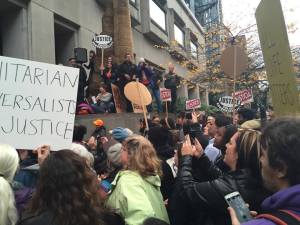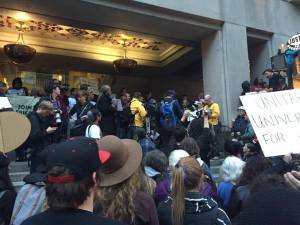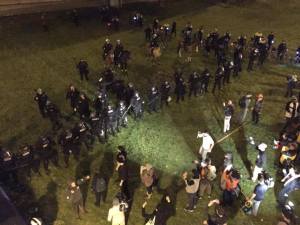Along with cities from around the country, Portland erupted on November 25th in one of the largest demonstrations and actions it has seen in years. The Portland Solidarity Network came on as an official sponsor of the event that was planned in solidarity with the Mike Brown actions happening both in Ferguson and in cities across the country.

After the fatal shooting of Mike Brown in Ferguson, Missouri this last August, Officer Darren Wilson was cleared by a grand jury on November 24th. The jury was directed to determine whether or not there was probable cause to level formal charges against Wilson, which could range from first-degree murder down to involuntary manslaughter. The jury determined that no charges were to be filed, in a decision that many were saying was coerced by a mishandling by the District Attorney’s office.
In Portland, the Albina Ministerial Alliance and the Urban League put the solidarity action together. In front of the Justice Center, they called together over two thousand people to a rally that targeted the racist police violence that has become commonplace both in our city, and the U.S. broadly. The people present overwhelmed the area, taking Third Street over as well as the park on the other side. Speakers ranged from local organizations and churches, each putting out a call to create a movement that has the force to confront the kind of mammoth power of institutional racism and white supremacy. After an emotional round of Eyes on the Prize was sung, a speaker from the AMA came up and boiled the issues down to their essence.
“The blood of Michael Brown cries out for justice today. Across this nation, and across the world. Once again, the African American community, communities of color, mental health communities, the poor, the marginalized, citizens who love justice and democracy, those who have been crushed by the decision of the grand jury not to indict Officer Darren Wilson for the killing of Michael Brown. Once again we rise at the criminal justice system of America, and law enforcement is tainted with racial bias when it comes to rendering justice and fairness for black people. For communities of color. For the disenfranchised and the marginalized. We know from our own experience here in the city of Portland, that the brokenness of the criminal justice system and law enforcement. We know from Kendra James. We know from James Chasse. We know from Aaron Campbell. We know from Keaton Otis, that there is no justice and fairness when it comes to white police officers killing black and brown and poor people and mentally ill people.”
“What must we do about it? We must not go back to our old routines, and just talk about it. No, no, a thousand times! We must fight to change this broken, unjust and unfair system. We must use these times of injustice to build a movement!”
 Speakers came forward from the NAACP, the All-African All-People’s Revolutionary Party, various churches, Jefferson High School, and many others to draw together the issues of police violence and racism to the various struggles in the city. A student from Portland State University’s Black Student Union spoke powerfully and bluntly.
Speakers came forward from the NAACP, the All-African All-People’s Revolutionary Party, various churches, Jefferson High School, and many others to draw together the issues of police violence and racism to the various struggles in the city. A student from Portland State University’s Black Student Union spoke powerfully and bluntly.
“Do not go quietly into that dark night! This happens a thousand times in America. But we have an opportunity to rise up and use our collective voices to tell America, ‘Enough is Enough!’ … American, how much more do you want us to bear? We bore the injustices of slavery. We bore the injustices of the lies of emancipation. We bore injustices of segregation. We bore indignities of Jim Crow. We bore the annihilation of our communities. We bore the brunt of mass incarceration. We bore the debt of your housing market. We bore the magnitude of under and unemployment. We bore the assassination of our leaders, and now our children. How much more America? What is the cost of justice and freedom? What is the mortgage on the lives of black and brown folks? How many more payments before you reduce the principle balance on our freedom? “
“When will black lives matter?”
Speakers from the Committee for Human Rights in the Philippines and the All-African People’s Revolutionary Party drew the killing right back to capitalism, imperialism, and the need for revolutionary change and international solidarity. A call here was really to get involved in ongoing organizing efforts, from challenging police violence to related movements such as housing struggles and labor.
A march was then led, through downtown with a population that over swelled even the roads. The memetic chant “Hands up! Don’t shoot!” was common, with people focusing directly on the targeting of young people of color that has marked the city in recent years. There was a sense of group solidarity as major unions, non-profits like Basic Rights Oregon and the NAACP, and more radical organizations like the Black Rose Rosa Negra Anarchist Federation and the International Socialist Organization stood together with a complementary vision. As the march wound back to the Justice Center, the AMA led a final talk about Michael Brown’s family and led a chorus of old spiritual activist songs and a candlelight vigil.
At this point a large contingent began to form that did not want to end the action at that point, many calling for direct action at the Justice Center openly. From a third to half of the crowd broke away at this point and led an unpermitted march that again took the streets over and head towards the Morrison Bridge. Here protesters began to push against the forming police force in an effort to take the bridge, with police beginning to shove through the crowd and drive motorcycles into the crowd.
The march moved back down the street and took over the Burnside Bridge, making it across the river and blocking the intersection on the other side. Moving through the Water District, the next spot was to openly block Interstate 5 from a park, the same way that organizers have done so in Oakland and Los Angeles. It was at this point that the police force took another turn and began attacking protesters with the riot-prepared troops and cavalry. As hundred of protesters attempted to stage a sit-in on the freeway and/or occupy the park, the police began swinging batons and letting pepper spray loose. Participants of color had to be treated by street medics for pepper spray directly into their eyes, which is an irony that must have been lost on the Portland Police Department. A former member of the Portland Solidarity Network, and close ally, was seriously injured by police batons, and had to be cared for by a street medic before being rushed to the emergency room.
A move was made to take the next bridge and head back into downtown, though police were beginning to pick off large portions of protesters by blocking them onto portions of the bridge and going for mass arrests. Luckily, many people were saved from being taken into custody as unarrests in the chaos of the freeway action were roundly successful. From here protesters made it in the direction of PGE Park, where a now fully militarized police force began using crowd control measures. Though there were seven arrests reported, the numbers could have been much higher without a conscious move by the people on the ground to keep the crowd together and to watch out for the treatment of fellow protesters. Things ramped up even more aggressively as the police riot van had its windows smashed in and there were reports of protestor injuries increasing rapidly. The rest of the crowd eventually made it to Waterfront Park, where final speeches were made and a commitment given to keep this fight going into the long-term.
An action like this shows both the passion and desire that is necessary for mass movements, and the ability to think in a more radical context to directly confront the kind of racial animosity that has tarnished our local and national institutions. Though we are incredibly happy to see the actions play out as they have, we also want to see this turn into long-term organizing that will be able to continue to target this systemic inequality. The kind of racism that was implicit and led to both the shooting of Mike Brown by Darren Wilson, and the several police murders in the Portland area, is just as prevalent in people’s workplaces and housing situations. Redlining, Section 8 and rental discrimination, unequal foreclosure rates, and inaccess to public housing all mark institutionalized housing oppression against people of color in our communities. We are committing to work with tenants across the city to use community solidarity to force concessions and change in people’s neighborhoods and housing complexes. These racial issues are not just at play in loud points of cruel violence, but also the subtle evictions that we see in apartment complexes across all cities and the kind of gentrification that turns previously communities of color into trendy shopping centers for upper-class whites. Let’s take the anger and determination that we saw on November 25th and continue to challenge these institutions, and hopefully we can use this as an opportunity to spotlight the racism that is central to the unequal access to housing in this city and country.
Originally published at Portland Solidarity Network on November 26, 2014.
